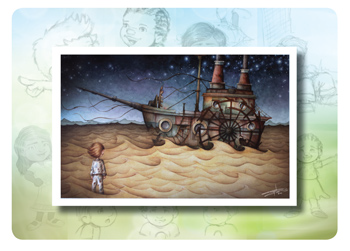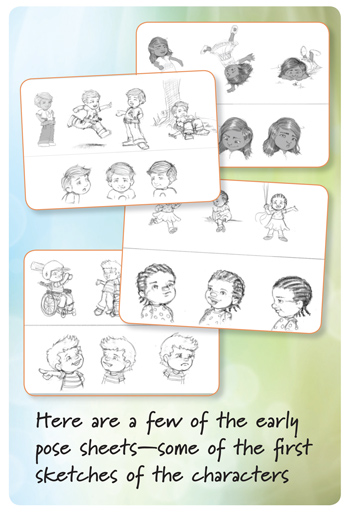Joseph Cowman
Published: 2013
In last month’s Author Spotlight, you met Mike Huber, author of the first books to be released by our new imprint, Redleaf Lane. This month, we’re excited to introduce you to Joseph Cowman, the illustrator of those six books. Talking to Joseph provided a great opportunity to learn more about a subject we don’t usually get to explore—the world of art and illustration! In this special Illustrator Spotlight, we had lots of fun asking Joseph questions about his workspace, his favorite illustration, and the other creative projects he has worked on.
Which books did you love as a child?
At a very young age, I was introduced to Where the Wild Things Are and I completely loved it! The storytelling is so natural. Maurice Sendak did a brilliant job capturing the essence of childhood imagination and whimsy along with the yearning for independence and resolution. Years later, as a teen, I was given Faeriesby Alan Lee and Brian Froud and was obsessed with the illustrative work.
Did you always know you wanted to be an illustrator?
When I was young, I was sure I would become a scientist or an inventor; I built all kinds of different contraptions out of old stuff I found. I knew I wanted to create; I just wasn’t sure which direction I would go. It wasn’t until I was introduced to Arthur Rackham and Alan Lee’s illustration work that I started to think about illustration as a career.
Tell us about your career in art.
In my early twenties, I focused mainly on fine art. I’ve been able to do several gallery shows, and I even had the opportunity to be part of a two-man show at The Art Museum of Eastern Idaho. Even my fine art always had an illustrative quality about it, so the transition to children’s art was totally natural. My children were little, and much of the literature coming into the house was children’s. That’s when I really fell in love with children’s art and children’s literature. I wanted to be a part of the group that introduced art and literature into young children’s lives.
I had the opportunity to work with Moonshoot under the supervision of Suzanne Barchers, and she was a great mentor! I illustrated several English-language storybooks and an equal number of activity books. Since then, I have had the chance to work on toy and doll design (which my girls loved!), and I’ve worked on environment, packaging design, and eBook applications. I have worked commercially, as well, for companies like World Wind and Solar. Recently, I started working in fine art again, and I’m looking forward to working on fine art concurrently with children’s art!
Of all of the illustrations and projects you’ve done so far, do you have a favorite piece?
Yes!
This illustration was the first finished page from a story written by my wife for our son, Phoenix. Phoenix is in awe of everything he sees, and I felt that I really captured that emotion with this piece.

Where do you work on illustrations? Show us your space!
I first started in art with watercolor and I still love working in it. Now I split my time between traditional work (watercolor) and digital. I started working on a Cintiq about three and a half years ago, and I don’t know what I ever did without it! The freedom I have with composition and alterations is invaluable.

What is your process for illustrating children’s books? How do you begin to develop characters?
When I read through a manuscript for the first time, I read it as though I’m reading it to my own kids. If I can see the visual side of the story emerge as I read, then I know the story is a good match for me. Without that connection, I don’t feel that I would do justice to the writer’s vision. I can definitely imagine the illustrations in my mind, but I find that putting those ideas down on paper can take a while. Sometimes I’ll draw the same character ten times before they look organic. I think that’s the goal for me: for my characters to feel like they’ve always existed. The inspiration for my characters comes from everywhere: my kids, my wife, friends and family, everyone I’ve ever met. There are compelling characters everywhere. One year, my daughter Alina showed me her class picture and one of her classmates was so interesting, so funny, that I just had to include him somewhere in my work.
What do you do if you run out of inspiration?
The good news is that with a house full of kids, inspiration is never far. Everything in the world is a discovery waiting to happen for a child, every event is a new experience. I love that! I love to watch the fascination with which kids see the world. I’m also lucky enough to have my wife Kari by my side. She’s always there to bounce ideas off of. She’s a fresh eye with new perspective, a spark of energy when I need it most, she has always encouraged me and supported what I do 100%. I couldn’t do it without her!
It’s also really helpful for me to look at visual story telling information. The Internet gives me an endless library of art reference. If I’m having trouble with a certain aspect of a project—for example, body expression—I can have hundreds of examples in front of me within 30 seconds. There are so many amazing artists out there that it really is inspiring!
What were the most difficult and easiest elements of illustrating the six Early Experiences books?
The easiest element in this project was recognizing the different characters' personalities. Mike Huber did such a fantastic job capturing the characters that I found myself reading through the stories and thinking, "I know that kid!" It helped me to form an idea of who these kids were before they even existed on paper. Some of the characters came to life immediately and that was awesome! The most difficult part of the process was that some of the characters didn't want to translate onto paper. There were two or three characters that had to be drawn several times over before I really nailed their personality. In the end, though, I feel confident that we really captured everyone in the stories.

What kinds of things fill your time when you aren’t illustrating?
Throughout the years, I’ve built so many different things: a hydraulic arm out of old tubing and syringes, a marble maze out of junk wood from the barn, a cable-driven robotic arm, Halloween masks, an electronic key card lock (this was 1992, so it felt technologically advanced), and that same year, I built an alarm clock that turned the television on in the morning. That was Back to the Future style. I wish I had pictures of that stuff.
I constructed this Halloween mask out of cardboard and covered it in faux leather. Next to me is my daughter Savannah in a headless costume that I put together for her.

My wife and I remodeled the kitchen in our first house. We designed and built the entire kitchen—hood range, refrigerator, etc.—from scratch. I even got the chance to pour concrete countertops, inlaid with coins from our first trip overseas.

Learn more and see a full list of titles by Joseph Cowman.